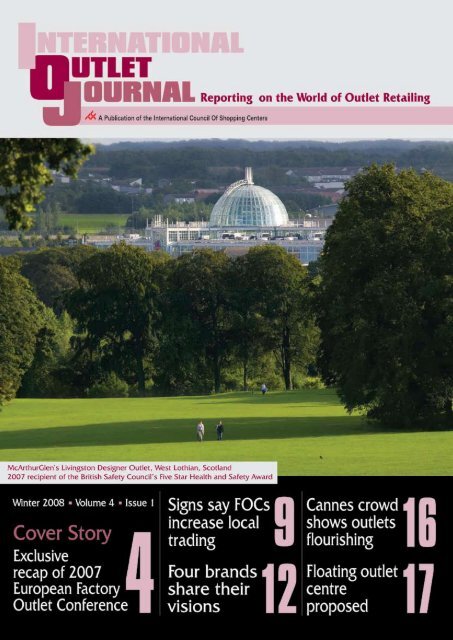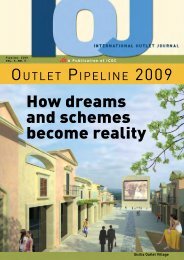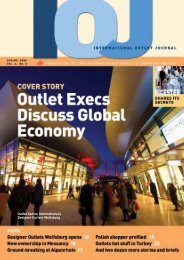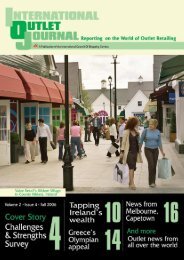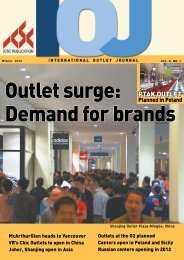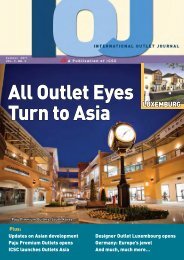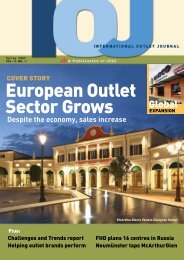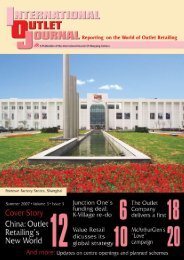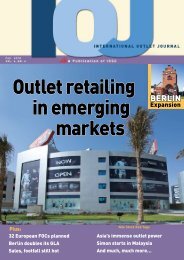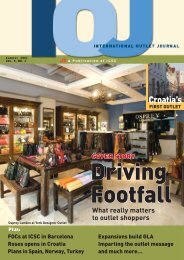Winter 2008 Issue - Value Retail News
Winter 2008 Issue - Value Retail News
Winter 2008 Issue - Value Retail News
You also want an ePaper? Increase the reach of your titles
YUMPU automatically turns print PDFs into web optimized ePapers that Google loves.
Outlet enthusiasm strengthens<br />
Outlet executives share research, tips, trends at conference<br />
More than 150 people from 28 countries across three continents<br />
attended the 2007 European Outlet Conference held at the Landmark<br />
Hotel in London in October. The event was hosted by the<br />
International Council of Shopping Centers and its publications, <strong>Value</strong><br />
<strong>Retail</strong> <strong>News</strong> and the International Outlet Journal. Sponsors of the<br />
two-day conference were GVA Grimley Outlet Services, Henderson<br />
Global Investors, ING Real Estate and Aareal Bank.<br />
The continuing evolution of the outlet retail sector was apparent<br />
as delegates expressed widely differing views on issues such as centre<br />
State of the Global Outlet Industry<br />
Brendon O’Reilly, GVA Grimley Outlet Services<br />
David Ober, Partner, PA Outlet Management Services<br />
OppOrtunities waiting<br />
all arOund the glObe<br />
Across Europe, with its population<br />
of 459 million people in the Euro-<br />
pean Union, there are 142 factory<br />
outlet centres trading in 25 countries with<br />
a further 34 FOCs proposed to open within<br />
the next 12 to 18 months, according to<br />
figures announced by Brendon O’Reilly of<br />
GVA Grimley Outlet Services.<br />
As borders across Europe open up, the<br />
concept is quickly taking hold in more<br />
countries as these New Europeans become<br />
increasingly brand-aware.<br />
“With Polish workers moving to the UK<br />
and other Western European countries for<br />
employment,” O’Reilly said, “the country<br />
they leave behind has opened its borders<br />
to workers from the Ukraine. Now they<br />
are discovering for themselves the delights<br />
of brand shopping in the new Polish factory<br />
outlet centres.”<br />
The Ukraine has huge potential for European<br />
developers, he added, pointing out<br />
that “with a population of over 58 million,<br />
many of whom are hugely aspirational,<br />
there are currently no factory outlet centres<br />
open there, although two are proposed.”<br />
However, some countries are reaching<br />
outlet saturation. The UK has 48 factory<br />
outlet centres with one more at Gloucester<br />
Quays due to open in early 2009.<br />
That’s no indication that the sector is<br />
washed up in Western Europe, though. <strong>Retail</strong>ers<br />
are taking note of their competitors’<br />
success in factory outlet centres and are<br />
asking for their own piece of the action.<br />
O’Reilly highlighted apparel retailers<br />
Fat Face and Tula and UK department<br />
store John Lewis, all of which are now<br />
establishing outlet chains.<br />
InternatIonal outlet Journal u <strong>Winter</strong> <strong>2008</strong><br />
In Western Europe, he said, that nation<br />
of brand-shoppers called Italy has<br />
room for growth. “Currently in this<br />
country there are 17 outlet centres with<br />
three more proposed in a population of<br />
58.5 million. In Ireland, too, with a<br />
population of just 4 million, the number of<br />
people with a significantly high disposable<br />
income indicates expansion potential.”<br />
The jewel in the crown of opportunities,<br />
according to O’Reilly, is Germany.<br />
Despite a challenging planning regimen,<br />
the recent relaxations in the country’s<br />
Sunday trading laws have heralded an upsurge<br />
in development interest. Currently<br />
Germany has just five outlet centres with<br />
five proposed in a country which has a<br />
population of over 82 million.<br />
O’Reilly also highlighted a 25 percent<br />
growth in the number of recent transactions<br />
in European factory outlet centres<br />
by predominantly institutional funding.<br />
David Ober presented a vision of a<br />
vibrant outlet centre industry in the<br />
U.S., where every one of its top 30 outlet<br />
centres is in expansion mode and where<br />
brands are looking for more opportunities.<br />
Ober is a partner in U.S.-based PA<br />
Outlet Management and president of the<br />
industry trade group Developers of Outlet<br />
Centers & <strong>Retail</strong>ers.<br />
Speaking of outlet development outside<br />
the U.S., Ober said the Asian outlet sector<br />
includes nine centres in China, Japan and<br />
Korea, totalling 5.3 million sf.<br />
With six centres in Turkey, one in<br />
Dubai and 16 in Australia, New Zealand<br />
and South Africa, the factory outlet centre<br />
is now a truly global phenomenon, he<br />
branding and tenant-landlord partnerships during the conference’s<br />
10 seminars and keynote presentation – often followed by lively<br />
conversation and debate during the socializing/networking functions.<br />
The programme was filled with trends, research, case studies and<br />
ideas, all specifically related to this forward-thinking, global factory<br />
outlet industry.<br />
London-based writer Nicky Godding has provided IOJ with<br />
an exclusive recap of the programme’s educational sessions, which<br />
follows on the next few pages.<br />
Brendon O’Reilly<br />
David Ober<br />
said. But the emerging outlet centre industry<br />
elsewhere in the world should learn<br />
from the U.S. experience where developers<br />
and retailers took many years to trust each<br />
other enough to work together. n
Balanced Scorecard:<br />
Building Brands And Business<br />
James Kirby, Fund Manager, Henderson Global Investors<br />
Outlets perfOrm during<br />
ecOnOmic dOwnturns<br />
Henderson Global Investors’ Outlet<br />
Mall Fund, currently working<br />
with operator McArthurGlen and<br />
worth e 850 million, is targeted to grow<br />
to e1.5 billion over the next few years.<br />
Henderson’s outlet mall strategy is to own<br />
those centres that are the best in their class,<br />
regionally strong, with suitable catchment<br />
areas and GLA over 20,000 m².<br />
The recent turbulence in the markets<br />
– due to the credit squeeze, high oil prices<br />
and increasing competition from High<br />
Street – could slow Henderson’s ambitions,<br />
according to fund manager James<br />
Kirby. He suspects interest rates will drop<br />
during the next few months.<br />
“Outlet centres are counter cyclical,”<br />
he said. “They tend to out perform<br />
other retail sectors in an economic<br />
downturn.”<br />
Another factor contributing to this<br />
not just the brands, it’s the experience,”<br />
is how Ken Gunn, associate<br />
“It’s<br />
director of CACI, sums up the way<br />
to succeed in the factory outlet sector.<br />
With so many new outlet centres<br />
opening (more are scheduled to open<br />
this year in Europe than in any year since<br />
the concept was first launched in Europe<br />
in 1984), Gunn said that outlet centres<br />
need to raise their game to successfully<br />
compete with town centres and each<br />
other for consumer spending.<br />
“I’m concerned that the number of<br />
schemes we have is threatening the unique<br />
proposition that was behind the original<br />
concept,” he said, adding that this concern<br />
will come into greater focus over the coming<br />
years as more centres open.<br />
“As shoppers have moved to larger<br />
centres offering more choice,” he said,<br />
“the investment has been concentrated<br />
in these centres and in new locations,<br />
including retail parks. As a result there<br />
InternatIonal outlet Journal u <strong>Winter</strong> <strong>2008</strong><br />
optimistic view is migration, which raises<br />
brand awareness. “There is 15 percent<br />
migration in the European Union, higher<br />
than the U.S.,” he said. “These immigrants<br />
tend to be well-qualified and<br />
aware of European brands.”<br />
However, recent competition from<br />
High Street and supermarket discounting<br />
has focused the fund, and Kirby warns<br />
that outlet centres must retain their point<br />
of difference to maintain their success.<br />
“Outlet centres need to be leading edge<br />
to compete with the full price sector and<br />
the Internet in the future,” he said. “That<br />
means competing on leasing, marketing,<br />
customer service, making outlet centres<br />
a brand and improving innovation and<br />
technology.”<br />
According to figures released at the<br />
conference by Henderson, Poland and<br />
the UK have the highest outlet space<br />
Feasibility and the Consumer Proposition<br />
Ken Gunn, Associate Director, CACI<br />
Henrik Maris, Factory Outlets Consultancy<br />
Keep Outlets interesting<br />
Or risK lOsing shOppers<br />
has been a decline of smaller, less competitive<br />
centres as they struggle to find<br />
the investment to maintain their share<br />
of the pot. This has brought about a fundamental<br />
shift in shopping patterns from<br />
small to big, reducing the opportunity for<br />
smaller centres to attract the investment<br />
to change their situation.”<br />
Henrik Maris, president of Factory Outlets<br />
Consultancy, cautions that the High<br />
Street environment is moving into outlet<br />
centres, and the presence of too many<br />
department store clearance stores can be<br />
detrimental. “Outlet centres need to work<br />
closer with the true retail brands,” he said.<br />
Whilst the UK has a status quo, the<br />
continent is steaming ahead with new<br />
innovations, he added. “We should link<br />
centres to attractions not just catchment.<br />
Think about traditions in each market,<br />
because if people don’t know your brand,<br />
they often won’t buy it.”<br />
According to Gunn, maturing outlet<br />
James Kirby<br />
per capita, with over 10 million m² in<br />
Poland and around 9.75 million m² in<br />
the UK. Turkey has less than 2 million<br />
m² of outlet space.<br />
However, Kirby predicted that consumer<br />
spending will grow the most in the<br />
New European countries such as Estonia,<br />
Romania and the Slovakian Republic,<br />
with more modest growth in established<br />
markets such as the United Kingdom,<br />
Portugal and Switzerland. n<br />
Henrik Maris<br />
Ken Gunn<br />
centres will need to keep refreshing their<br />
offer. “People arrive at outlets centres in<br />
a happy mood – the industry’s job is to<br />
keep them that way.” n
Best Practices: Points for the Industry’s Future<br />
Lisa Wagner, The Mega Company<br />
Manuel Lagares, Managing Director, Neinver<br />
Ivor Peters, Managing Director, Primal PR<br />
Chris Warren, Partner, Cushman and Wakefield<br />
factOry Outlet standards:<br />
nuisance Or necessity?<br />
The establishment of hard and<br />
fast best practice standards could<br />
inhibit the outlet centre sector’s<br />
growth and jeopardise its future, according<br />
to the panellists in this session.<br />
“We see the free market approach as<br />
being better,” said Manuel Lagares of<br />
Neinver, “but it is clear that some industry<br />
standards need to be followed in order to<br />
please the customers.”<br />
Chris Warren of Cushman and Wakefield<br />
agreed. “The most important thing<br />
to consider when developing a new outlet<br />
centre is not to confuse the customer.”<br />
Chris Warren<br />
need to know your customer<br />
before you put your spade<br />
“You<br />
in the soil,” said Peter Noble of<br />
<strong>Value</strong> <strong>Retail</strong>, whose customers often travel<br />
thousands of miles to visit one of its outlet<br />
villages in the major cities in Europe.<br />
Noble also believes that viewing an<br />
outlet centre’s catchment by a 23 minute<br />
drive-time (an industry average) is way off<br />
the mark. <strong>Value</strong> <strong>Retail</strong> promotes its villages<br />
as serious tourism destinations – think 23<br />
hours rather than 23 minutes catchment.<br />
“We promote our villages to aspirational<br />
people, marketing ourselves as chic<br />
outlet shopping in Europe,” he said. “To<br />
InternatIonal outlet Journal u <strong>Winter</strong> <strong>2008</strong><br />
The panel concurred that a significant<br />
proportion of potential customers still<br />
don’t understand what an outlet centre is,<br />
and retailers could help this confusion by<br />
conforming to the accepted outlet-centre<br />
discount of 30 percent.<br />
In 1996 in Spain and in 2002 in Poland,<br />
Neinver set out to explain outlet retailing<br />
to its consumer. However, Neinver still feels<br />
that the concept isn’t fully understood.<br />
As shoppers become more savvy, the<br />
issue of made-for-outlet goods begins to<br />
pose questions in consumers’ minds.<br />
But Ivor Peters of Primal PR said<br />
Manuel Lagares Ivor Peters<br />
Closing the Gap in Branding and Positioning<br />
Peter Noble, Group Senior Leasing and Commercialisation<br />
Director, <strong>Value</strong> <strong>Retail</strong><br />
branding, pOsitiOning<br />
have the same gOal<br />
reach our target customer, we market our<br />
centres as destinations using dedicated<br />
tourism marketing experts within our<br />
marketing and communications teams.”<br />
To follow <strong>Value</strong> <strong>Retail</strong>’s example,<br />
outlet centres could attract their target<br />
audience by:<br />
l Marketing to higher social group<br />
women aged 25-60 who visit just once or<br />
twice a year with friends<br />
l Marketing to women who aren’t<br />
afraid to spend<br />
l Negotiating exclusive tie-ins with<br />
upmarket publishers, such as Conde Nast<br />
l Launching gift cards programmes<br />
consumers are always going to have questions.<br />
“In the future they will ask, ‘Is it<br />
green, ethical or fairly made?’”<br />
Lagares said, “Customers need to know<br />
what they are buying. Brands are proud<br />
of their name and they need to maintain<br />
their image.”<br />
Lisa Wagner of Bucharest-based Mega<br />
Company said that a few years ago in the<br />
U.S. there was an avalanche of negative<br />
publicity about whether outlet goods<br />
were inferior, so the industry launched a<br />
campaign and created a stamp of outlet<br />
authenticity. “It didn’t last long but the<br />
message got out that the industry was<br />
trying to police itself,” she said. “The time<br />
may be coming for the EU outlet industry<br />
to start policing itself.”<br />
Ultimately, the industry’s success lies in<br />
the partnership between tenants and landlords,<br />
Lagares said. “Our retailers know their<br />
business, and we don’t want to interfere,<br />
but exchanging information is important.<br />
By creating value for our brands, we are<br />
creating value for our customers.” n<br />
Lisa Wagner<br />
Peter Noble<br />
for the target customer<br />
And perhaps a change in perspective<br />
is necessary for a centre’s branding to<br />
precisely reflect its target customer.<br />
“At <strong>Value</strong> <strong>Retail</strong> we consider ourselves<br />
retailers working for retailers,” he said. “In<br />
the end, branding and positioning are the<br />
same thing.” n
John Drummond Mark Clark Neil Thompson Clive Woodger<br />
Centre Branding: What’s in a Name?<br />
John Drummond, Managing Director The Guinea Group<br />
Mark Clark, Business Development, GVA Grimley Outlet Services<br />
Neil Thompson, Chief Executive Officer, The Outlet Company<br />
Clive Woodger, Managing Director, SCG<br />
fOc branding reflects<br />
reputatiOn, emOtiOn<br />
Centre branding should begin<br />
long before the marketers are<br />
appointed; it must start right at<br />
the beginning of a project, embedded in<br />
the architect’s plan.<br />
“If the architects don’t know the proposition,<br />
what hope has the centre got?” said<br />
Clive Woodger, architect and managing<br />
director of SCG.<br />
Panellists hotly debated what branding<br />
means, with opinions differing on whether<br />
branding an outlet centre detracts from<br />
the retailers within it or whether people<br />
visit a centre because they know that its<br />
brand represents their own aspirations.<br />
Mark Clark of GVA Grimley felt that<br />
consumers didn’t need to be educated<br />
about a shopping centre. They just need<br />
to know how they will benefit from visiting<br />
one, and that’s what an outlet centre<br />
brand should convey, he said.<br />
Panellists agreed that a consumer’s reaction<br />
to a brand isn’t completely rational.<br />
“Branding is a product plus the emotional<br />
values invested in it by the consumer,” Clark<br />
said. “When we debate the factory outlet<br />
centre business, we hear much rational<br />
analysis of the likelihood of potential success<br />
Outlets’ Impact on Traditional <strong>Retail</strong><br />
Dr Joachim Will, Chief Executive Officer, Ecostra<br />
surprise! signs say<br />
Outlets increase sales<br />
Do outlet centres harm High<br />
Street?<br />
Outlet centres might be a<br />
niche market, but in Germany the sector<br />
is growing, despite its bumpy beginning<br />
there. In the late 1990s prevailing opinion<br />
was ardently against factory outlet<br />
centres, as they were seen as a threat to<br />
local retailing.<br />
The accusation rarely comes up anymore,<br />
largely due to positive results that<br />
changed the minds of the outlet-wary,<br />
said Dr. Joachim Will of Ecostra.<br />
In 2001, despite enormous opposition<br />
in the locality, Outlet Centres International<br />
opened Designer Outlets Zweibrücken<br />
(DOZ) in southwest Germany,<br />
“in the middle of nowhere,” Will said.<br />
Since opening, the Zweibrücken centre<br />
has attracted millions of visitors, has shown<br />
steady sales increases, is constantly refreshing<br />
its tenancy, and thanks to the recently<br />
relaxed German Sunday trading laws, it<br />
can now open 16 Sundays per year.<br />
So what happened to the local retailers<br />
who were supposed to be killed off by the<br />
outlet centre?<br />
According to Will, up to now there have<br />
been no town-planning consequences, no<br />
trading-down effects. The main streets<br />
have a high stability with persistent inquiry<br />
for stores, even while there are almost<br />
no empty retail units in Zweibrücken.<br />
The predicted drop of 20-30 percent<br />
of a new centre based on drive-time and<br />
demographics, but this research takes little<br />
account of a consumer’s mood swings.”<br />
Good branding cannot make up for<br />
deficiencies elsewhere in a centre, he said.<br />
Branding works well as long as everything<br />
else works equally well.<br />
“We are not a brand in the true, retailer,<br />
sense of the word,” Clark said. “But<br />
we behave like one.”<br />
Woodger warned panellists not to confuse<br />
branding and marketing.<br />
“Branding is about image and reputation<br />
– it’s what people say about you when<br />
you’ve left the room,” he said. “Right<br />
from the beginning, consumers will start<br />
to have a view about your centre, its<br />
developers, its managers as well as the<br />
retailers and the brands they sell.”<br />
He urged developers to look at their<br />
brands from every angle – how it looks on<br />
a text, on a Google search, on the website,<br />
in advertising – even on You Tube, and to<br />
involve the outlet centre’s stakeholders in<br />
its development. n<br />
Dr. Joachim Will<br />
in sales didn’t happen and there were<br />
no recognisable job losses. Whilst some<br />
retailers reported a small drop in sales,<br />
the overall effects were minor. Instead,<br />
it has boosted the city’s retailers’ determination<br />
to up their game and in<br />
(See Suprise!, page 10)<br />
<strong>Winter</strong> <strong>2008</strong> u InternatIonal outlet Journal
Surprise!<br />
(Continued from page 9)<br />
September 2007, a former city-centre<br />
Kaufhalle department store was converted<br />
to City Outlet, featuring 2,700<br />
m² of retail space over three floors selling<br />
toys, electrical goods and sportswear.<br />
Success of this new store has yet to be<br />
measured, but retailers are optimistic.<br />
However, other synergies envisaged by<br />
the outlet centre development company<br />
didn’t happen, and visitors didn’t flood<br />
from the outlet centre into the city.<br />
Now Zweibrücken has decided that<br />
having a successful outlet centre in the<br />
region isn’t such a bad thing after all and<br />
The Power of Footfall<br />
Karen Isman, Marketing Director, Chameleon <strong>Retail</strong> Consultancy<br />
Mike Davidson, <strong>Retail</strong> Operations Director, Land Securities<br />
Chris Green, Head of Marketing Communications, McArthurGlen<br />
Didier Harm, Managing Director-Leasing, MDG Europe<br />
universally agreed<br />
that fOOtfall is all<br />
Footfall is the single most important<br />
element of a shopping centre, along<br />
with the retailers themselves, according<br />
to Karen Isman of Chameleon<br />
<strong>Retail</strong> Consultancy.<br />
Continuing the debate begun in the<br />
previous session on branding, the panellists<br />
discussed whether the brand or the<br />
marketing campaign attracts the most<br />
visitors to a centre.<br />
According to McArthurGlen’s Chris<br />
Green, successful branding and marketing<br />
will increase quality footfall, not<br />
footfall overall. “We want visitors to find<br />
and buy the products they want, rather<br />
than attracting the tyre-kickers,” he said.<br />
McArthurGlen has reportedly decided<br />
not to heavily brand its centres, instead<br />
allowing the brands within the centre to<br />
speak for themselves.<br />
“It’s about quality of retailers and the<br />
10 InternatIonal outlet Journal u <strong>Winter</strong> <strong>2008</strong><br />
it now plans to position itself as “the<br />
outlet shopping region” with main attractions<br />
such as DOZ, City Outlet and<br />
traditional factory shopping in the village<br />
of Hauenstein, well known for its shoes.<br />
A similar energy boost to the city centre<br />
happened in Ingolstadt, where <strong>Value</strong><br />
<strong>Retail</strong> opened an outlet village in 2005.<br />
After the opening, a full-price shopping<br />
centre, City Arcaden, opened with 8,000<br />
m² of retail floor space and 38 stores. Up<br />
to now, there have been no store closings.<br />
However, unlike Zweibrücken, Ingolstadt<br />
retailers have reported more visits to their<br />
stores by those who have travelled long<br />
distances to shop at the outlet centre. A<br />
report on the effects of Ingolstadt Village<br />
experience of consumers within the centre,”<br />
he said. “People want to come back<br />
because they enjoy themselves.”<br />
Mike Davidson of Land Securities<br />
urged adoption of a loyalty scheme similar<br />
to one introduced at his UK outlet centre,<br />
Gunwharf Quays.<br />
“We now have more than 40,000<br />
people on our database, thanks to our<br />
loyalty card,” he said, explaining that<br />
the card was introduced when the centre<br />
opened, with the blessing of the retailers.<br />
The programme is now so successful that<br />
other partners outside the centre want to<br />
get involved.<br />
Didier Harm of MDG Europe agreed.<br />
“The best boosts to footfall are loyalty or<br />
outlet credit cards, and the tenant line-up<br />
within the centre.”<br />
Whether footfall can be increased<br />
by one-off events was open to debate,<br />
on the city centre concluded there was<br />
only a limited influence on local shopping.<br />
Instead, visitors to the outlet centre<br />
came from much further afield and those<br />
living in and around Ingolstadt continue<br />
to do their everyday shopping in the<br />
West Park shopping centre or in the city<br />
centre itself.<br />
If outlet centres have been perceived<br />
as a threat to city centres, they have galvanised<br />
local retailers into improvements<br />
they should have been making anyway. In<br />
Germany, city centres have seized the opportunity<br />
to market themselves to a much<br />
wider national and possibly international<br />
audience, promoting their own cultural<br />
offerings. n<br />
Mike Davidson Karen Isman Didier Harm<br />
Chris Green<br />
according to panellists, but they must<br />
benefit the retailer – a difficult thing to<br />
achieve.<br />
Davidson said that major events build<br />
awareness “but smaller events that happen<br />
regularly involving the local community<br />
are important because they attract<br />
the locals, who are your most frequent<br />
customers.”<br />
All agreed that different marketing<br />
methods were needed for different audiences,<br />
with one of the most effective<br />
being Web-based with selective emailing<br />
and downloadable vouchers. Advocacy<br />
marketing was also highlighted, where<br />
those on the database pass on offers to<br />
their friends.<br />
Research is absolutely vital, with the<br />
most successful centres conducting ongoing<br />
research to finesse their product<br />
and consumer offer.<br />
The relationship with retailers again<br />
came under the spotlight, with panellists<br />
bemoaning that there are always retailers<br />
who don’t get involved because they are<br />
concerned about the effect marketing will<br />
have on their full-price stores.<br />
“When we reassure them that they are<br />
targeting a new customer, not encouraging<br />
a full-price customer to an outlet<br />
centre, they are more inclined to get<br />
involved,” Green said. n
<strong>Retail</strong> Runway<br />
Moderator: Neil Chapman, Chief Executive Officer,<br />
Chameleon <strong>Retail</strong> Consultancy<br />
retail runway:<br />
4 brands share their visiOns<br />
Outlet retailers want amenities – air<br />
conditioning, plenty of stock-room<br />
space, large windows and a good<br />
location within the centre. In return, they<br />
say, they’ll deliver a great shopping experience<br />
for customers. Four brands shared their<br />
company’s strategies for creating good values<br />
for landlords and consumers, as well as their<br />
plans for expanding their chains.<br />
Puma<br />
Kristofer Jürgensen, International<br />
Expansion Manager, PUMA AG<br />
The Puma brand<br />
is based on<br />
three pillars: sport<br />
performance, sport<br />
lifestyle and sport<br />
fashion. Although<br />
Puma’s core is the<br />
sport performance<br />
line, the most in-<br />
Kristofer Jürgensen<br />
come comes from the sport lifestyle line.<br />
In the past, Puma was seen as the<br />
underdog against competitors such as<br />
Adidas and Nike, but it has recently developed<br />
a more aggressive development<br />
strategy and is determined to be one of<br />
the main footfall generators in a centre.<br />
Its retail mission for its full-price stores<br />
is to promote the Puma brand with no<br />
franchised stores. Its retail mission for its<br />
12 InternatIonal outlet Journal u <strong>Winter</strong> <strong>2008</strong><br />
factory outlet stores is to allow Puma to<br />
follow its full price strategy in its concept<br />
stores and secure effective distribution of<br />
excess inventory.<br />
The company plans to grow its business<br />
in Europe over the next few years and currently<br />
has franchised stores in countries<br />
such as Russia and Poland. It is keen to<br />
open in areas which it feels have the most<br />
potential, such as the Czech Republic,<br />
Hungary, Romania and Germany.<br />
Jürgensen says that the company is<br />
happy to sign up at the early development<br />
stage of an outlet centre and is looking for<br />
500-sf to 600-sf spaces in locations with<br />
good footfall.<br />
“We don’t see Puma outlets boosting<br />
our brand,” Jürgensen said, “but they<br />
don’t do us any harm. We have a profitability<br />
target, not a sell-through target.”<br />
Group SEB<br />
Franck Larzilliere, Vice President<br />
Home and Cook<br />
Group SEB is the world leader in small<br />
domestic equipment, according to<br />
Larzilliere, with sales around e 2.7 billion.<br />
It sells more irons, food processors, kettles<br />
and toasters than any other retailer in the<br />
world, and is a leading player in countries<br />
such as France, Spain, Portugal, Canada,<br />
Mexico, Russia and Turkey, as well as in<br />
Central Europe and the UK.<br />
Formed in 1957 in Burgundy, France,<br />
over the last three decades SEB has<br />
bought up a number of highly regarded<br />
brand names such as Moulinex, Rowenta<br />
and Krups and now has a roster of many<br />
international and local brands, including<br />
All-Clad. As a manufacturer – not as a<br />
retailer – the name SEB is only known in<br />
France and Belgium, but it employs nearly<br />
14,000 people in 51 countries<br />
SEB entered factory outlet retailing two<br />
years ago because it wanted direct access<br />
to consumers and to sell out-of-date products.<br />
Now the company has launched<br />
an ambitious expansion programme and<br />
expects to open 40 new stores in the next<br />
three years throughout the world.<br />
“Home and Cook is the name of our<br />
shop but our brands are more important,”<br />
said Franck Larzilliere. “We offer products<br />
which are not well represented in factory<br />
outlet centres.”<br />
The company also operates some factory<br />
outlet stores under the Lagostina and Tefal<br />
banners, but SEB is currently rebranding<br />
them as Home and Cook stores.<br />
Le Creuset<br />
Petra Schuler, Development<br />
Manager-Business & European<br />
<strong>Retail</strong>, Le Creuset<br />
Whilst Petra Schuler admits that<br />
L e C r e u -<br />
set isn’t perhaps<br />
the footfall driver<br />
that other retailers<br />
claim to be, she<br />
says that this upmarket<br />
cookware<br />
c o m p a n y a d d s<br />
value to a factory<br />
outlet centre.<br />
Petra Schuler<br />
Le Creuset is a private company founded<br />
in 1925 in Fresnov Le Grand, France,<br />
where the first cocotte, or casserole dish,<br />
was produced.<br />
Now it is a leading company in enamelled<br />
cast iron kitchenware, as well as wine<br />
and bar accessories, with 90 percent of its<br />
sales coming from exports to more than 60<br />
countries.<br />
Le Creuset has over 1,000 employees<br />
throughout the world in 17 commercial/<br />
marketing/distribution subsidiaries.<br />
In Europe the company currently operates<br />
21 outlet and two full-priced stores,<br />
and in the U.S., 50 outlet and three fullprice<br />
stores. Le Creuset also operates<br />
stores in South Africa, Japan and Korea.<br />
Le Creuset admits that new markets are<br />
(See Le Creuset, page 14)
Le Creuset<br />
(Continued from page 12)<br />
difficult for their business because people<br />
like to spend their money on clothes: “You<br />
can’t wear a Le Creuset around your neck,”<br />
Schuler said. So rather than blazing a trail<br />
into a new country, the company waits until<br />
the market is established and then looks<br />
at the factory outlet centres available. The<br />
company has a three-to-five year window<br />
to show a profit on its outlet stores.<br />
“We want to be in outlet centres that<br />
don’t impact our wholesale business but will<br />
improve our brand recognition,” she said.<br />
Outlet <strong>Retail</strong>ing, Past, Present and Future<br />
Brendon O’Reilly, Partner, GVA Grimley Outlet Services<br />
David Ober, Partner, PA Outlet Management Services<br />
Henrik Maris, President, Factory Outlet Consultancy<br />
Phil Cottingham, Portfolio Director, Land Securities<br />
Nicky Lovell, Head of Client Management, McArthurGlen<br />
harsh lessOns prOve<br />
Only the strOng survive<br />
After the summer’s credit crunch,<br />
factory outlet centre investors<br />
will only be looking for the ‘best<br />
in class.’ As a result there is bound<br />
to be consolidation within the sector,<br />
especially in the saturated UK market,<br />
although there is still room for growth<br />
Keynote Presentation:<br />
Improving Customer Care at Outlet Centres<br />
Ros Gardner, Customer Care Excellence<br />
plumbing the depths<br />
Of custOmer lOyalty<br />
People change their marriage partners<br />
more often than they change<br />
their banks, according to customer<br />
care expert Ros Gardner, who spent 27<br />
years with retailer Marks and Spencer in<br />
Human Resources and then as head of<br />
customer care.<br />
Her experience in handling returned<br />
goods and managing customer<br />
expectations, especially<br />
regarding Marks and<br />
Spencer’s most ubiquitous<br />
items – underpants and<br />
ladies’ knickers – means<br />
there isn’t much that a<br />
dissatisfied customer can say<br />
that will surprise her.<br />
What is beyond discussion<br />
is that there is little<br />
Ros Gardner<br />
1 InternatIonal outlet Journal u <strong>Winter</strong> <strong>2008</strong><br />
Sunglass Time<br />
Rags Davenport, Sales and<br />
Operations Manager, Sunglass Time<br />
Sunglass Time was founded by Michael<br />
Cooney in 1998 to help distribute<br />
surplus designer sunglass stocks at discounted<br />
prices in outlet malls and villages<br />
throughout Europe.<br />
The retailer opened its first shop in<br />
1999 in the McArthurGlen outlet centre<br />
in York, UK where it traded from a 150-sf<br />
kiosk. Selling a wide range of designer<br />
sunglasses, it now has 10 stores in UK<br />
outlet centres, three in Italy and one each<br />
in continental Europe.<br />
The better projects will survive, but<br />
tougher questions are likely to be asked<br />
about the validity of a project before<br />
money is invested, according to David<br />
Ober from the U.S.<br />
With the benefit of his U.S. experience,<br />
loyalty anymore, and as the internet has<br />
made people more informed, outlet centre<br />
retailers are going to have to work a great<br />
deal harder to engage successfully with<br />
their customers.<br />
The potential for improved customer<br />
care to positively impact business is not in<br />
doubt, but it requires knowledge, experience,<br />
drive and total commitment<br />
to make it happen<br />
successfully, Gardner says.<br />
Focussing on the challenge<br />
of internet shopping,<br />
still seen as a threat by<br />
many outlet centre retailers,<br />
Gardner urged them to<br />
embrace the new medium<br />
as a huge opportunity.<br />
“Any retailer not engag-<br />
in Holland, Belgium, Germany, Austria,<br />
Ireland and the Czech Republic.<br />
Now, Sunglass Time is the biggest<br />
sunglass outlet operator in Europe, consistently<br />
introducing new lines. It has also<br />
strengthened its winter offer with a wider<br />
range of goggles and sports glasses.<br />
Sunglass Time sees outlet shopping<br />
as a major growth area and is looking<br />
for areas of 350 sf to 500 sf in highfootfall,<br />
upmarket outlet centres.<br />
Southern Europe is a particular focus<br />
for the retailer, where it has recently<br />
experienced a 50 percent increase in<br />
comp-store sales. n<br />
Ober stated that some outlet centres<br />
fail, but “a centre won’t fail if its retailers<br />
support it.”<br />
Ober reminded the audience that in<br />
the U.S. 2001 recession, a number of<br />
outlet chains closed their doors. He<br />
urged factory outlet developers to think<br />
globally and invite retailers to the table at<br />
the planning stage in order to understand<br />
their expansion ambitions.<br />
E-commerce is still perceived as a<br />
threat to bricks and mortar retailers, but<br />
outlet retailing can be the beneficiary:<br />
When E-tailers over-order and undersell,<br />
the excess stock often ends up in<br />
outlet channels. The panel agreed that<br />
E-commerce won’t triumph over those<br />
outlet centres offering a destination<br />
experience. n<br />
ing with customers through the internet is<br />
putting themselves at a big disadvantage,”<br />
she said. “Your customer relates closely to<br />
shopping and when they can do that in<br />
the comfort of their own home, you have<br />
to make it worth their while to visit your<br />
centre when they have the choice of going<br />
elsewhere – or not going anywhere at all<br />
and having it delivered to them. Customer<br />
expectations are rising – tomorrow they<br />
will want something more, so using every<br />
means of communication is essential.”<br />
Ros described the four typical customer<br />
groups:<br />
l The loyal and satisfied are your<br />
advocates<br />
l The loyal but not satisfied feel like<br />
hostages and must be rescued<br />
l The not loyal and satisfied are mercenaries<br />
who will shop anywhere<br />
l The not loyal and not satisfied are<br />
terrorists who won’t be happy no matter<br />
what<br />
Ros urged outlet centres not to waste<br />
time trying to please the last group. “You<br />
can sack customers if they’re never going<br />
to benefit your business,” she said. “You’ll<br />
never convert them to advocates.” n
Cannes crowd shows outlets flourishing<br />
By Linda Humphers, Editor in Chief<br />
In the last four years of attending<br />
Mapic, ReedMidem’s<br />
annual retail convention in<br />
Cannes, I’ve seen evidence everywhere<br />
that factory outlet retailing<br />
is flourishing and growing in<br />
Europe.<br />
Though many outlet development<br />
companies have fallen away<br />
from exhibiting at the mid-November<br />
deal making event – Freeport,<br />
McArthurGlen and Promos<br />
among the exceptions – business<br />
was bustling with meetings held in<br />
cafés and yachts surrounding the<br />
Festival Centre.<br />
Colin Brooks, managing director<br />
of UK-based Realm Ltd.,<br />
organized an outlet-industry<br />
forum during Mapic to discuss<br />
issues affecting the sector’s ongoing<br />
success. On everyone’s mind is whether the outlet<br />
sector in Europe will follow the same<br />
growth patterns seen in the UK and<br />
in the U.S.<br />
Brooks theorizes that planning approvals<br />
will stave off over-saturation,<br />
but he was intrigued by the possible<br />
emergence of a tiered-tenant system<br />
similar to that seen in the U.S. He was<br />
Brooks<br />
referring to the evolution in the U.S.<br />
of three types of centres tenanted by<br />
outlet retailers: pure outlet centres, value-oriented centres<br />
(a significant number of outlet tenants complemented by<br />
off-price/discount/local retailers) and lifestyle centres (an<br />
upscale combination of outlet tenants and traditional retailers).<br />
“This delineation is interesting,” Brooks said. “<strong>Retail</strong>ers<br />
choose which of their concepts to put in a centre and the<br />
landlord’s job is to help them choose<br />
which concept is right for that centre.”<br />
As the conversation turned to the<br />
trend toward institutional ownership,<br />
Neil Varnham said that Henderson<br />
Global Investors’ initial, almost accidental<br />
acquisition of McArthurGlen<br />
projects has progressed into such a de-<br />
liberate strategy that the asset management<br />
firm has created a fund specifically<br />
for outlet centres.<br />
“We’re not in the business of taking risks,” said Varnham, who<br />
is the director of retail property for Henderson.<br />
“We protect our clients’ money.<br />
The outlets are a retail business, which is<br />
completely different from the retail real<br />
estate business.”<br />
Recognizing the paramount importance<br />
of brands, the group turned to Pieter Van<br />
Voorst Vader of Nike to explain how his<br />
company views its retail mission.<br />
Van Voorst Vader<br />
“Nike is very liquidation-driven, very<br />
1 InternatIonal outlet Journal u <strong>Winter</strong> <strong>2008</strong><br />
In November, Colin Brooks, far left, managing director of asset management firm<br />
Realm, organized a forum in Cannes to discuss issues pertinent to outlet retailing.<br />
Varnham<br />
disposal-driven,” said Vader, who is Nike’s real estate manager.<br />
“Nike Outlets isn’t yet a retail business. We produce maybe 10<br />
to 15 percent for the outlets in Europe, usually a white t-shirt<br />
with a swoosh. <strong>Retail</strong> is a silo, with opportunities filtering down<br />
at every level. Sensitivity is very important to us, but we judge<br />
it by each and every location.”<br />
Varnham said that sensitivity was a huge worry when McArthurGlen<br />
was opening Roermond Designer<br />
Outlet in The Netherlands. “The impact<br />
turned out to be that retailing in the city<br />
of Roermond actually improved after the<br />
centre opened,” he said.<br />
Like their ownership and tenanting,<br />
outlet centres are ushering in new designs.<br />
According to Mike Nagelsztajn, director of<br />
Nagelsztajn<br />
S&P Architects, early outlet centres were<br />
cost-driven and often poorly designed.<br />
“They were initially designed to look cheap,” he said, “but<br />
that’s changing, and other elements, such as the food offer,<br />
are really improving.”<br />
The group thought that <strong>Value</strong> <strong>Retail</strong>’s Bicester Village was a<br />
major influence on outlet-centre design in the UK and Europe,<br />
with its emphasis on reflecting the local market and creating an<br />
intimate, town-centre environment.<br />
Nigel Robson, director of Londonbased<br />
Resolution Property plc, said that<br />
developers in Sweden, Spain and elsewhere<br />
were doing a number of things to<br />
add integrity to their projects. “To gain<br />
credibility with the tenants,” he said,<br />
“we’re seeing more partnering with estab-<br />
lished factory outlet developers.”<br />
Varnham concurred and said that con-<br />
Robson<br />
tinued consolidation was a sure thing, with more acquisitions<br />
likely by the big three outlet investors – Morley Fund, Hermes<br />
and Henderson.<br />
“How will consolidation benefit retailers?” Vader asked.<br />
“Consolidation leads to efficiencies in the operations and<br />
marketing spend,” Varnham said, “and it drives down costs<br />
while driving up quality and standards.” n
<strong>News</strong> from Cannes<br />
McArthurGlen<br />
rebrands itself<br />
Now that McArthurGlen has come out<br />
of the outlet closet to help brands open fullprice<br />
stores, the developer has decided to<br />
launch a new image campaign for itself. According<br />
to marketing director Chris Green,<br />
McArthurGlen’s mantra is to solve problems<br />
for brands, whether that means helping<br />
them disposing of last season’s products or<br />
finding new channels of distribution.<br />
“We’re not just the outlet guys anymore,”<br />
Green said. “We really want to<br />
broaden the way brands think of us.”<br />
After thoroughly reviewing its own marketing<br />
process, McArthurGlen saw that it<br />
needed a completely integrated marketing<br />
picture that blended 40 different opportunities<br />
into a cohesive message.<br />
“This is all being developed with the<br />
retailers in mind,” said Green, who was an<br />
executive with Getty Images before joining<br />
the retail sector. “We work with over<br />
700 brands, so our business isn’t about the<br />
properties, it’s about the brands.”<br />
McArthurGlen has hired Vogue magazine<br />
photographer Christian Schuller to<br />
do the business-to-business and businessto-consumer<br />
art.<br />
Keeping up with OCI<br />
Although the opening of its second centre<br />
in Germany was just weeks away, Outlet<br />
Centres International’s Hans Dobke,<br />
Stefan Schafer and Regina Leitner were in<br />
Cannes, keeping their business ball rolling.<br />
Invitations to the 15 December opening<br />
of OCI’s Designer Outlets Wolfsburg had<br />
been posted, and Dobke, who is the director<br />
of OCI, was already talking about the<br />
centre’s planned 10,000-m² phase 2.<br />
“We’ll open phase 2 in summer/fall<br />
2009,” he said, adding that the expansion<br />
was already 20 percent preleased. The<br />
11,500-m² phase 1 opened 80 percent occupied<br />
and is expected to be 100 percent<br />
leased by this summer.<br />
OCI, with its eye on a third German<br />
outlet project, is in a bidding war for a<br />
site 50 to 75 miles south of Hamburg.<br />
The winning bid is scheduled to be<br />
announced mid-year. After revealing<br />
this news, Dobke casually mentioned a<br />
planned fourth site in Germany, but he<br />
wasn’t giving out any details.<br />
<strong>2008</strong> busy for Promos<br />
Filippo Maffioli, sales director of<br />
Brescia, Italy-based Promos, said that<br />
Palmanova Outlet Village in Udine, Italy,<br />
which was scheduled to open in February,<br />
will have an unusual phase 2 – the expan-<br />
McArthurGlen’s marketing director Chris Green stands in front of the developer’s<br />
new creative, unveiled at Mapic, shot by Vogue photographer Christian Schuller.<br />
sion will feature a hotel, resort, fitness<br />
centre and restaurants. “Phase 2 will<br />
open at the end of the year,” he said.<br />
Additionally, Promos’ Lake Malaren<br />
Outlets will open in Shanghai in March,<br />
and Pescara Outlet Village on the Adriatic<br />
Coast will open in the autumn.<br />
“And I’m getting married in <strong>2008</strong>,”<br />
Maffioli said. “It’s going to be a pretty<br />
busy year for me.”<br />
Floating outlet<br />
centre proposed<br />
Ubaldo De Vincentiis, president of<br />
Europ Invest, based in Italy and Belgium,<br />
was in Greece when he got the idea for<br />
the Luxury Outlet Ship.<br />
“In Greece, there are lots of islands<br />
and not much good shopping,” he said.<br />
“There are beautiful ports, but big ships<br />
can’t get into them. So I thought of a<br />
ship with 60 to 100 duty-free outlets that<br />
would not only be important because of<br />
tourism, but could offer special events,<br />
leisure and entertainment.”<br />
The ship is being built in Italy by a<br />
Greek company and is expected to launch<br />
Ubaldo De Vincentiis<br />
in 2009, he said. De Vincentiis hasn’t<br />
nailed down a lot of the venture’s details,<br />
but he isn’t worried. His affiliations with<br />
outlet projects in Serravalle, Valdicchiana,<br />
Pescara and Zagreb are always on the<br />
front end: “I start the process and then<br />
the developer takes over the leasing, marketing<br />
and management,” he said. “Once<br />
I sell the property, I’m out of it.”<br />
De Vincentiis has some sketchy ideas<br />
on where the ship will sail (from Russia to<br />
the Mediterranean) and definite ideas on<br />
who the tenants should be. “Of course,<br />
we need some recognized brands,” he<br />
said, “but I would like to bring together<br />
about 100 small manufacturers and have<br />
them create exclusive, made-for-outlet<br />
goods. This idea brings the possibility of<br />
growth to the hundreds of small manufacturers<br />
all over the world.<br />
“I don’t agree that an outlet centre has to<br />
copy McArthurGlen and <strong>Value</strong> <strong>Retail</strong>.”<br />
A new day dawns<br />
for Freeport Limited<br />
Now that the long process of obtaining<br />
new ownership has been completed,<br />
Iestyn Roberts and Chris Milliken of<br />
Freeport have been working on improving<br />
Freeport Limited’s projects in Sweden,<br />
Portugal and the Czech Republic,<br />
as well as gaining approvals for a new<br />
scheme in France.<br />
At Freeport Lisbon Designer Outlet, the<br />
cinema has reopened and a relaunch programme<br />
of the entire scheme is in place,<br />
as is a new centre manager. “For the first<br />
time we now have a local person managing<br />
the centre and we feel that he’ll build a lot<br />
of bridges with the tenants,” said Roberts,<br />
who is CEO of Freeport.<br />
Leisure activities at the Lisbon centre,<br />
(See Freeport, page 18)<br />
<strong>Winter</strong> <strong>2008</strong> u InternatIonal outlet Journal 17
<strong>News</strong> from Cannes Continued<br />
Freeport<br />
(Continued from page 17)<br />
including paintball, skateboarding and<br />
five-sided football, are doing well alongside<br />
traveling exhibitions and museum displays,<br />
he said. “I’m thinking of putting in a wax<br />
museum,” he said. “We have one in Excalibur<br />
(in the Czech Republic) that’s quite<br />
popular, especially the figures of Saddam<br />
Hussein and Arnold Schwarzenegger.”<br />
Freeport’s Excalibur is doing “hugely<br />
well,” Roberts adds, with footfall up 35<br />
percent and trading up 28 percent from last<br />
year. Roberts attributes much of the success<br />
to, again, a local centre manager who’s<br />
adept at reading the market and working<br />
with tenants. That centre is 90 percent<br />
leased and should be full soon, he says.<br />
At Freeport Kungsbacka in Sweden,<br />
trading is up 15 percent and the centre’s<br />
occupancy has grown to almost 90 percent.<br />
“An ICA supermarket is opening<br />
next door in March, and that will be good<br />
for us,” he said.<br />
Now that the outlet portfolio is owned by<br />
Carlysle Group – the deal closed on 3 September,<br />
2007 – Freeport is once again on the<br />
development track, according to Roberts.<br />
“We’ve pledged to rebuild the portfolio,<br />
mostly from ground-up development,” he<br />
said. “We have a strong base and we’re<br />
well-capitalized now. And after five years<br />
we’ve gotten our approvals for our Roppenheim-Alsace<br />
centre [in France]. We<br />
hope to start construction around Easter<br />
and open the centre in autumn 2009.”<br />
Roberts said Freeport was also looking<br />
at a couple of acquisitions, but “the prices<br />
are still too optimistic.”<br />
Land Securities set<br />
to de-merge itself<br />
Peppered with questions about Land Securities<br />
radical split plan, which came into<br />
public view in November during Mapic,<br />
portfolio director Phil Cottingham explained<br />
that the new structure would simply<br />
“formalize the way it already works.”<br />
Land Securities, the UK’s largest real<br />
estate investment trust, will take about<br />
a year to separate itself into three main<br />
iOJ calendar<br />
1 InternatIonal outlet Journal u <strong>Winter</strong> <strong>2008</strong><br />
divisions: a property<br />
outsourcing<br />
REIT, a retail<br />
REIT, and a London<br />
REIT focusing<br />
chiefly on the<br />
office market.<br />
“The de-merger<br />
should make<br />
each division<br />
more nimble,” Phil Cottingham<br />
Cottingham said. Land Securities is<br />
involved in three factory outlet centres:<br />
Gunwharf Quays in Portsmouth, The<br />
Galleria Outlet Centre in Hatfield, both<br />
in England, and The Outlet at Bridgewater<br />
Park in Banbridge, Northern<br />
Ireland.<br />
Working closely with tenants is crucial<br />
in the outlet arena, he said. “We operate<br />
on the premise that customers aren’t loyal,<br />
that they have to be wooed all the time,”<br />
he said. “So we train shop staff and provide<br />
big incentives for well-run stores.”<br />
The Outlet Company<br />
seeks new frontiers<br />
Neil Thompson, CEO of Warsaw-based<br />
The Outlet Company, said he’s looking to<br />
the Ukraine and Russia as the next frontier<br />
for Fashion House Outlet Centres.<br />
“We’ve got some sites under discussion,”<br />
he said.<br />
Pioneering the outlet concept in Eastern<br />
Europe has already turned profitable<br />
for Thompson and company, as evidenced<br />
by the sale of phases 1 and 2 of Fashion<br />
House Warsaw in August to AIB’s Polonia<br />
II Fund for e45 million. The sale of<br />
the centre’s phase 3 – which opened 23<br />
November with such tenants as Tchibo,<br />
Park Avenue, Villeroy and Boch, Gardeur<br />
and Vision Express – is expected to take<br />
place in the first half of this year.<br />
“We are currently in negotiations with<br />
a party for FH Gdansk and FH Sosnowiec,”<br />
Thompson said, declining to be<br />
more specific. “Work began last week<br />
on Sosnowiec’s second phase (opening in<br />
September) and we expect to start work<br />
in the spring on the phase 2 at Gdansk,<br />
<strong>2008</strong><br />
15 February Spring IOJ deadline<br />
21-22 February VRN Spring Outlet Deal Making (Orlando)<br />
16-18 April ICSC European Conference (Amsterdam)<br />
21 April Summer IOJ -deadline<br />
18-21 May ICSC Spring Convention (Las Vegas)<br />
15-16 September VRN Fall Outlet Deal Making (New Jersey)<br />
13-14 October <strong>2008</strong> European Outlet Conference (London)<br />
with the opening in spring 2009.”<br />
The Outlet Company and GVA<br />
Grimley Outlet Services will continue<br />
to lease, manage and operate the centers<br />
for the new owners.<br />
BVS Villages to be<br />
the next generation?<br />
Alain Van Hulle, Barbara Horatz and<br />
Robert Van Den Heuvel, all of BVS<br />
Company Store Villages, were making<br />
the rounds letting everyone know that<br />
groundwork has begun on Alpenrhein<br />
Outlet Village in Landquart, Switzerland,<br />
and that the groundbreaking will be in<br />
March. The opening is scheduled for the<br />
end of this year or early 2009.<br />
“We’re about 25 percent leased with<br />
major international, German, Swiss and<br />
Italian designer brands,” said BVS managing<br />
director Van Hulle. “It’s a nice mix<br />
and we have a well-balanced merchandising<br />
plan for both sides of the center.”<br />
Van Hulle said BVS’ villages will<br />
be the next generation in European<br />
outlet centres: “There have been four<br />
generations,” he said. “We started with<br />
regenerations, then went to strip centers<br />
and U-shapes, then to village styles,<br />
where most are now. Our centres will be<br />
leisure/outlet centres, designed to draw<br />
more people for longer periods.” n<br />
JOHN L BuCKSBAuM, SCSM<br />
Chairman<br />
MICHAEL P. KERCHEVAL<br />
President and CEO<br />
RuDOLPH E. MILIAN, SCSM, SCMD<br />
ICSC Senior VP<br />
JAy STARR<br />
ICSC Senior VP<br />
Florida oFFice +1 727 781-7557<br />
FaX +1 727 781-9717<br />
29399 U.S. Hwy. 19 N., Suite 370<br />
Clearwater, FL 33761<br />
LINDA HuMPHERS<br />
Editor in Chief, ext. 472<br />
lhumphers@icsc.org<br />
RANDy GDOVIN<br />
Art Director, ext. 451<br />
rgdovin@icsc.org<br />
KAREN KNOBELOCH<br />
Advertising Prod. Mgr., ext. 441<br />
kknobeloch@icsc.org<br />
SALLy STEPHENSON<br />
Senior Advertising Executive<br />
+1 847 835-1617<br />
Fax: +1 847 835-5196<br />
sstephenson@icsc.org<br />
International Outlet Journal is a quarterly publication for<br />
the non-U.S. factory outlet industry. Copyright © 2007


